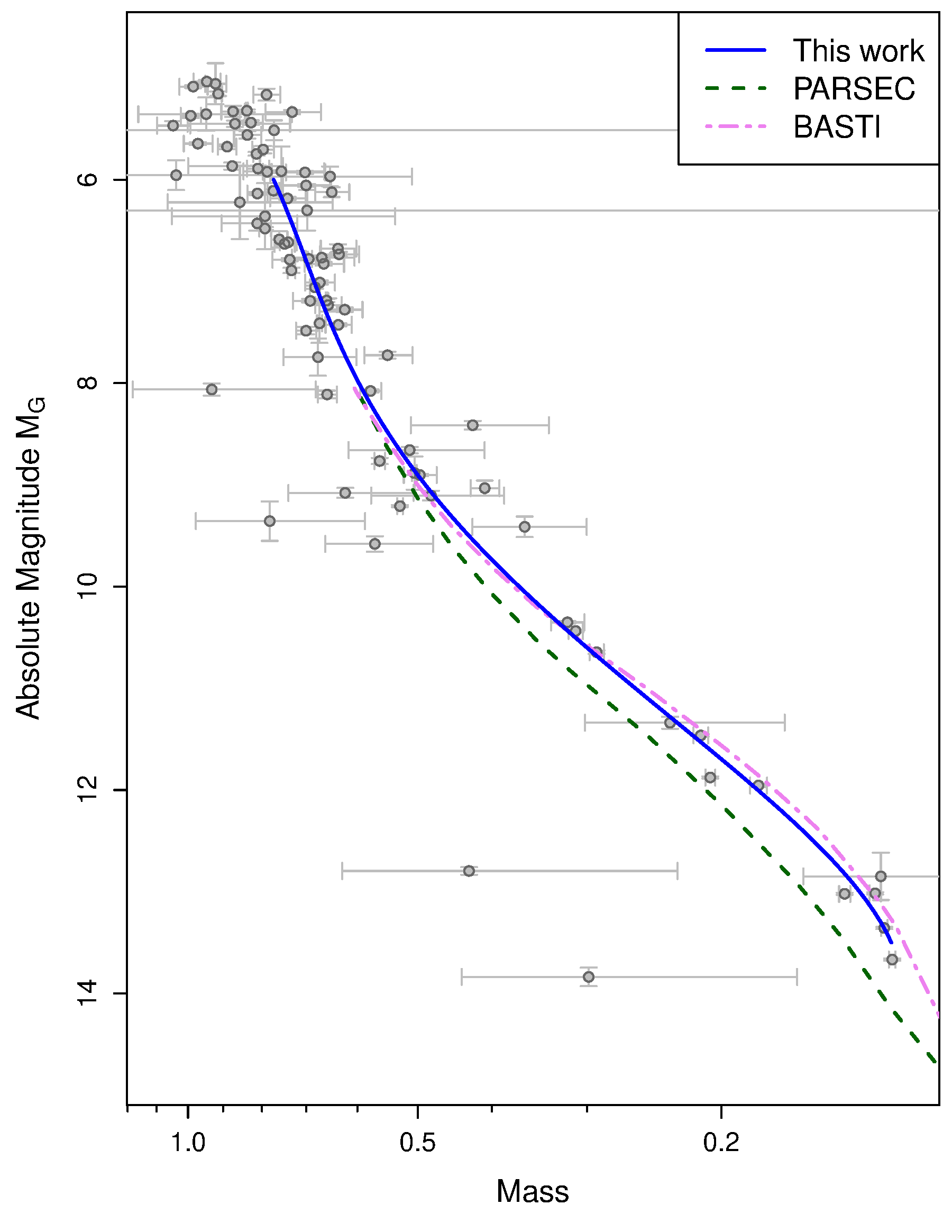IoW_20230922 - Gaia
Image of the Week
Mass-Luminosity relation from Gaia's binary stars
Figure 1. Mass-luminosity relation obtained using Gaia DR3 data. The stars characterized from Gaia data in combination with other literature data are in grey. The fitted mass-luminosity relation is given in blue. The dashed green and two-dashed pink lines are the solar metallicity isochrones for main sequence star of 1 Gyr for the PARSEC and BASTI stellar models respectively. Credits: Figure from the paper "Binaries masses and luminosities with Gaia DR3" by Chevalier, S. et al.
A bit more than a year ago, on 13 June 2022, the third Gaia Data Release (Gaia DR3) was published. It included for the first time an exciting new catalogue of Non-Single Star solutions. This catalogue counts around 440,000 sources with an orbital solution, either astrometric, spectroscopic, or eclipsing.
This data set can be useful in many ways, and particularly to determine dynamical masses. In fact, studying multiple stars' orbits is the best way to determine stellar mass directly from their motion. The masses and luminosities of 56 binaries have been obtained from the combination of Gaia astrometric data with spectroscopic data from two other catalogues (SB9 and APOGEE).
The orbital parameters provided by Gaia astrometry give two-dimensional information about the motion of the binary photocentre (the apparent light source) in the plane of the sky. They have been combined with double-lined spectroscopic (SB2) radial velocity data, which gives information on the 3rd dimension of the motion of both stars of the binary system and enables to fully characterize the orbit of both components. From this, individual masses and luminosity of each star can be estimated. Six additional binaries have been characterized, using direct imaging data and resolved Gaia astrometry and photometry.
Visualisation published for Gaia's Data Release 3 on 13 June 2022. The animation uses the Golden Sample of FGKM stars from Gaia Collaboration, Creevey, et al. 2023 A&A to illustrate how the physical characteristics of the stars - temperature and luminosity - are derived from Gaia observations. Full details for this video can be found from this page. Credit: ESA/Gaia/DPAC - CC BY-SA 3.0 IGO. Acknowledgements: This animation was produced by Laurent Rohrbasser (Univ. of Geneva, Geneva, Switzerland), Krzysztof Nienartowicz (Sednai, Geneva, Switzerland), in collaboration with Orlagh Creevey (OCA, Nice, France), Laurent Eyer (Univ. of Geneva, Geneva, Switzerland), Celine Reylé (UTINAM, CNRS, Besançon, France)
The intrinsic luminosity of a star depends on its mass, age, and metallicity. For solar neighbourhood stars, which have a metallicity mostly similar to our Sun, the relation between mass and luminosity on the main sequence is quite tight below ~0.6 solar masses. Above this mass, the mass-luminosity relation starts to be strongly dependent on the age of the star. With Gaia, both the apparent luminosity of the star and its distance are available, hence the intrinsic luminosity as well. So, for main sequence stars observed by Gaia, an estimate of their mass can be obtained from a well-calibrated mass-luminosity relation. This is the relation calibrated empirically with those new data (blue curve on the plot) and as published in the paper "Binaries masses and luminosities with Gaia DR3" by Chevalier, S. et al.
This empirical mass-luminosity relation also helps to constrain stellar evolution models (the green and pink curves on the plot are examples of such evolution models). To estimate the masses of single stars in the Gaia DR3 stellar parameters, the BASTI stellar evolution model has been used.
With Gaia Data Release 4 (Gaia DR4), the number of binary star orbits provided will be much larger. The availability of epoch data will also increase the number of sources that can be combined with literature data to derive masses. This expected increase should allow in particular to quantify the mass-luminosity variation with metallicity.
Story written by Simon Chevalier, Carine Babusiaux and Frédéric Arenou
Credits: ESA/Gaia/DPAC, Carine Babusiaux, Simon Chevalier, Frédéric Arenou
[Published: 22/09/2023]
- Removed a total of (10) style text-align:center;
- Removed a total of (7) style text-align:justify;
Image of the Week Archive
- Removed a total of (1) border attribute.
- Removed a total of (1) cellpadding attribute.
- Removed a total of (1) cellspacing attribute.








































 Sign in
Sign in
 Science & Technology
Science & Technology
